Fram Relay 帧中继
- 帧中继简介
- VC、LMI、DLCI的概念
- 帧中继映射
- Inverse-ARP的操作
- 帧中继配置
帧中继简介
分组交换广域网接入方式的一个代表,分组交换是以分组的形式在广域网的环境中穿梭的,
- 使用虚电路进行连接;
- 提供面向对象的服务;
介绍:
- 应用非常广泛的WAN(广域网)协议
- FR交换设备在用户路由器间建立虚电路,提供基于分组减缓的二层通道;
- 面向连接的数据链路技术
- 速率:56K - 2M
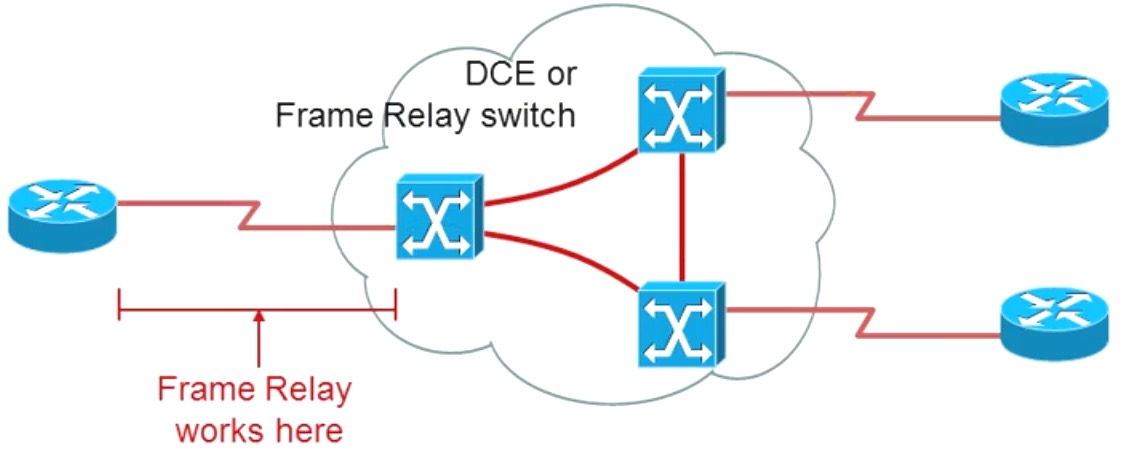
帧中继属于VC(虚电路):
- 通过帧中继网络实现的罗技连接叫做虚电路(VC);
- 利用虚电路,帧中继允许多个用户共享带宽,而无需使用多条专用物理链路,虚电路是以DLCI标识的;
DLCI(Data Link Connection Identifier) 数据链路连接标识:
- 通常由帧中继服务提供商(例如电话分公司)分配
- 帧中继DLCI仅具有本地意义
- DLCI 0 到 15 和 1008 到1023 留作特殊用途。服务提供商分配DCLI范围通常为 16 到1007
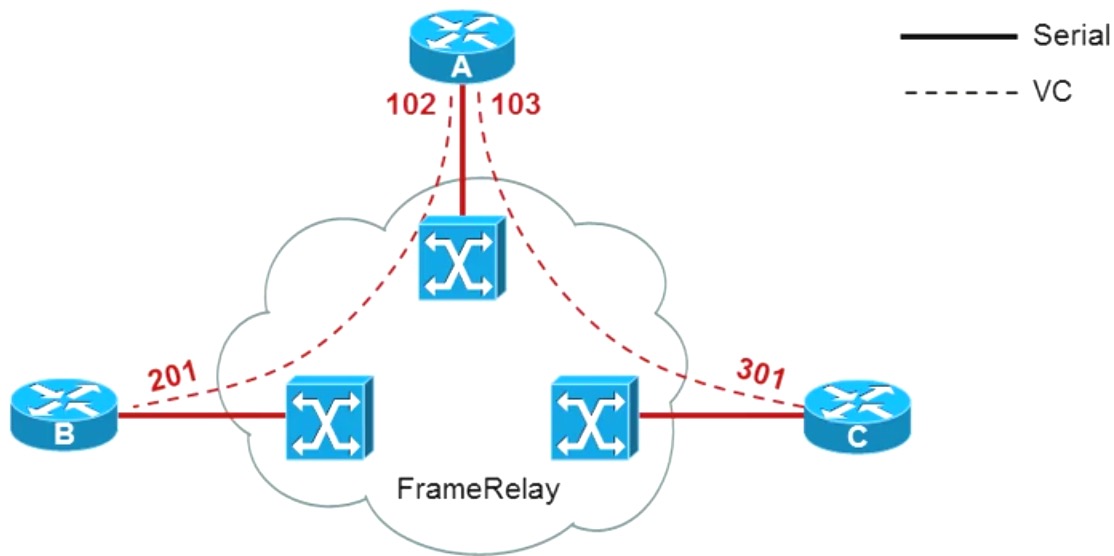
**帧中继术语LMI

LMI(本地管理接口)**
- 是一种信令标准,用于管理链路连接及keepalive的机制。
- 终端路由器(DTE)和帧中继交换机(DCE)之间的帧中继设备每10秒(或大概如此)轮训一次网络
- Cisco 路由器支持一下三种LMI:Cisco,Ansi,q933a
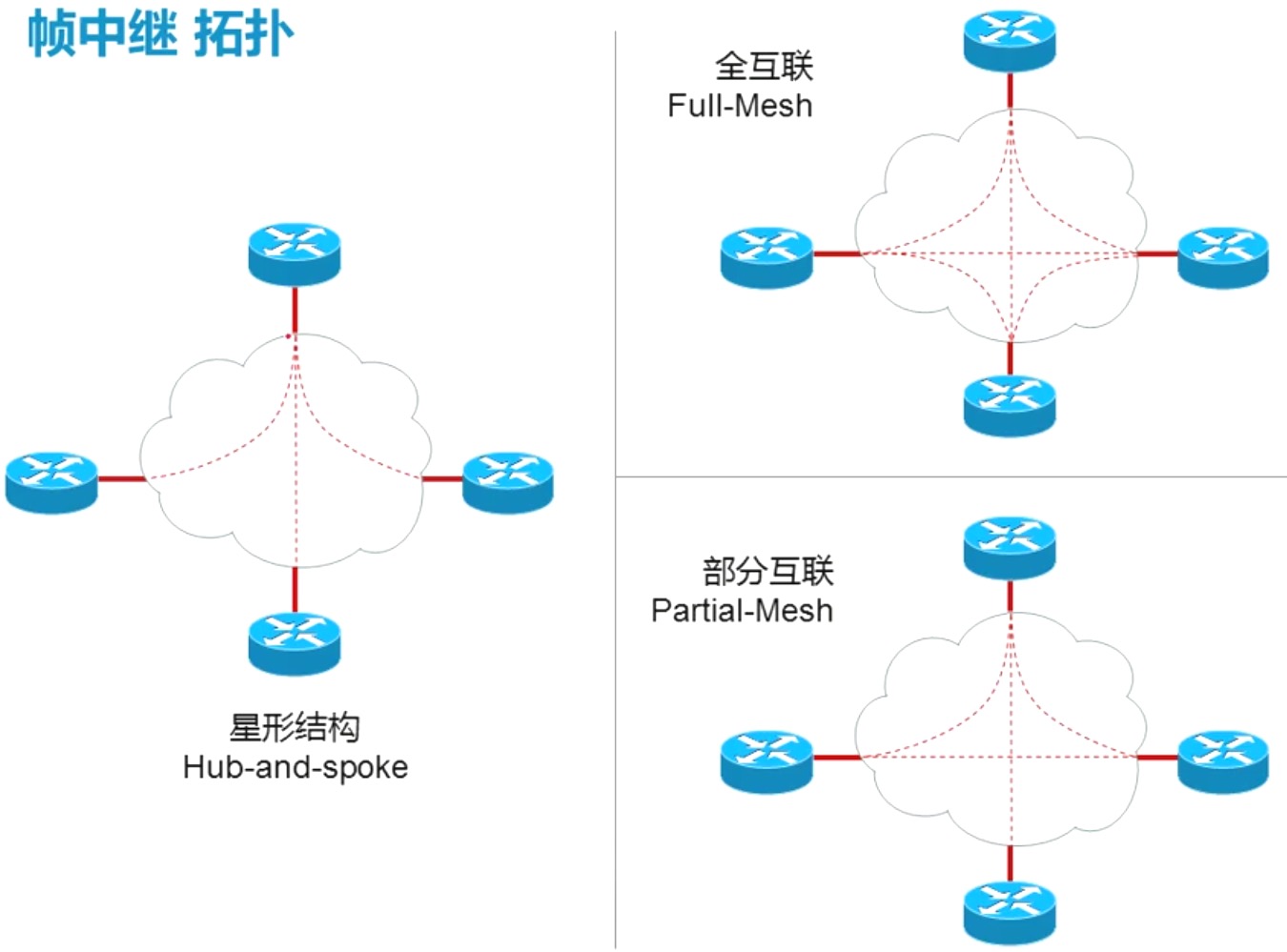
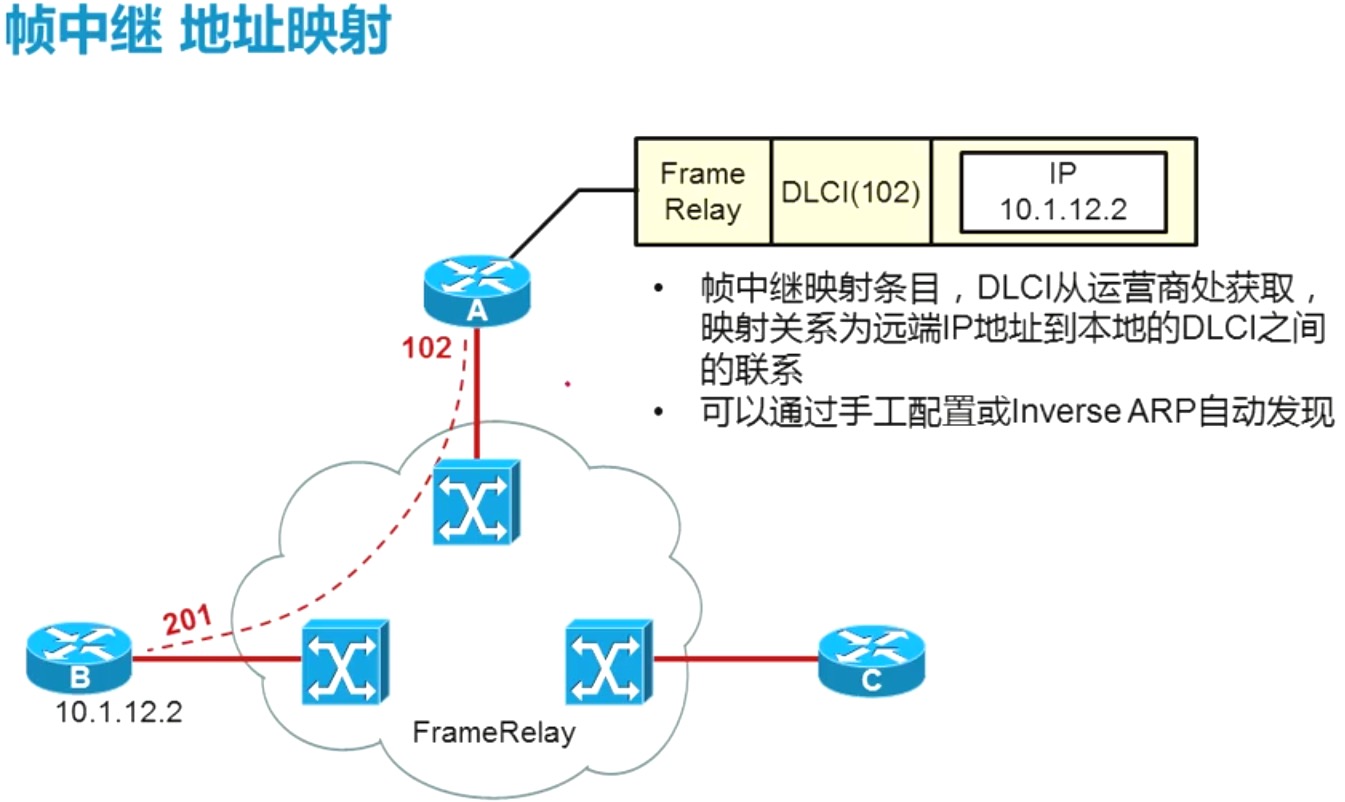

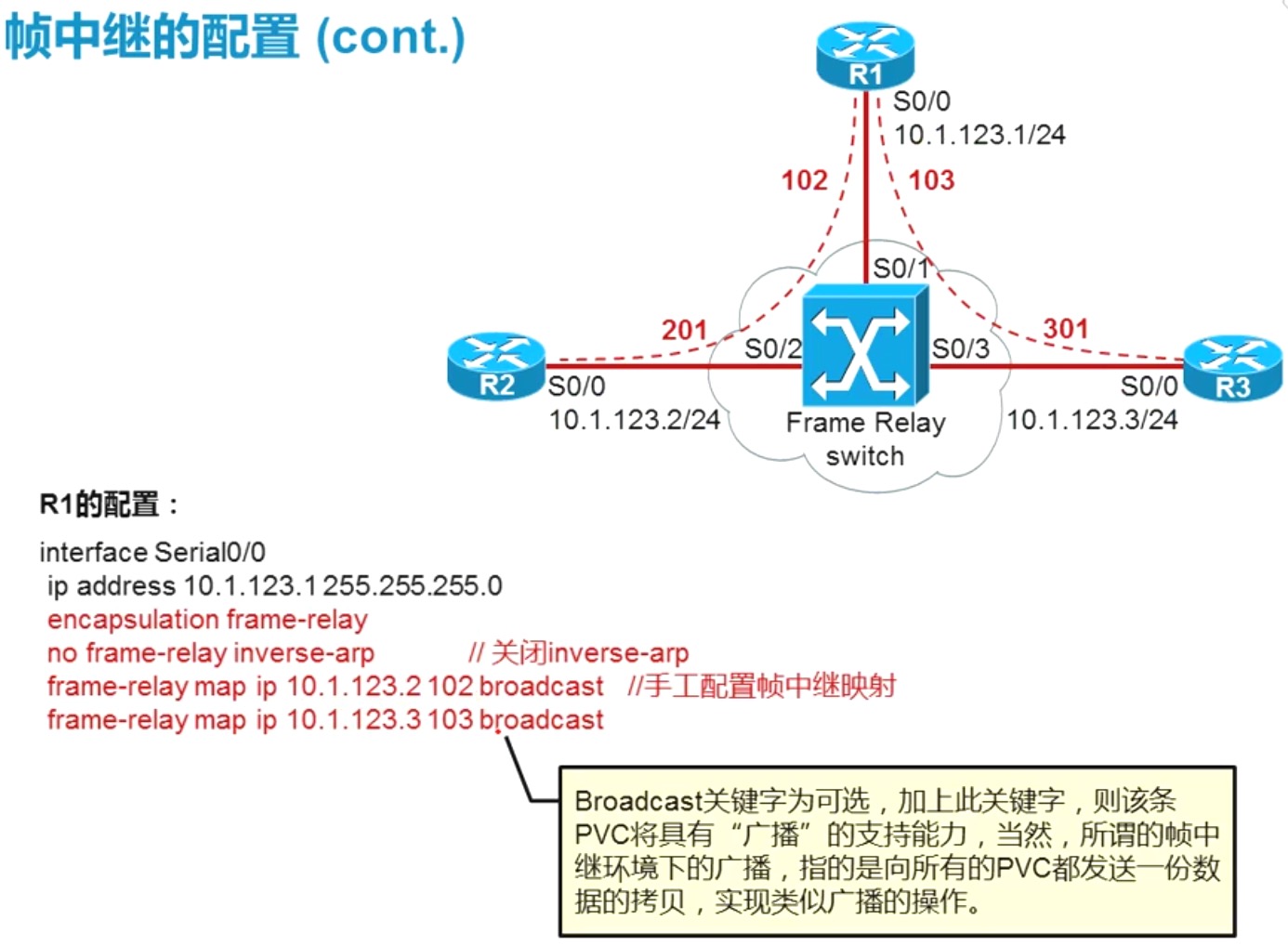

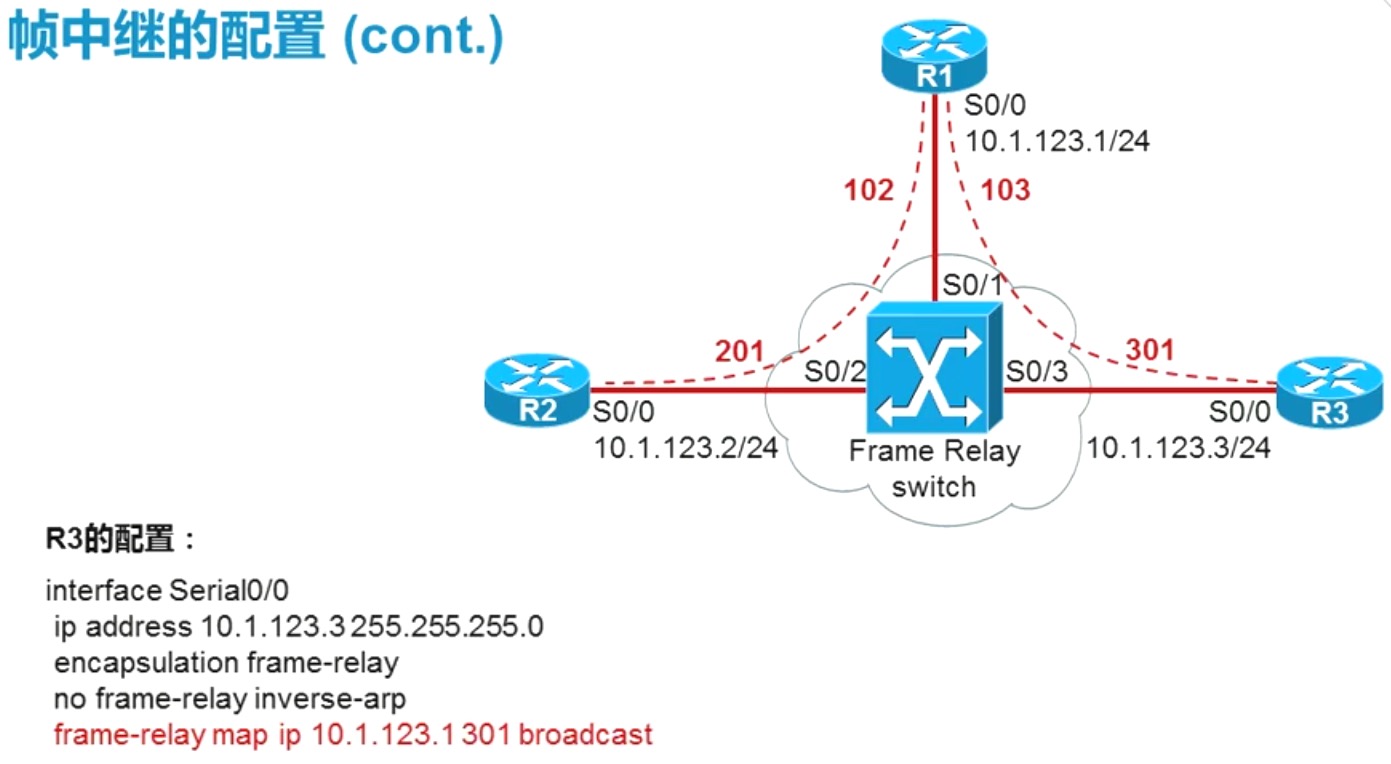
帧中继实验
根据下图拓扑,配置帧中继环境:
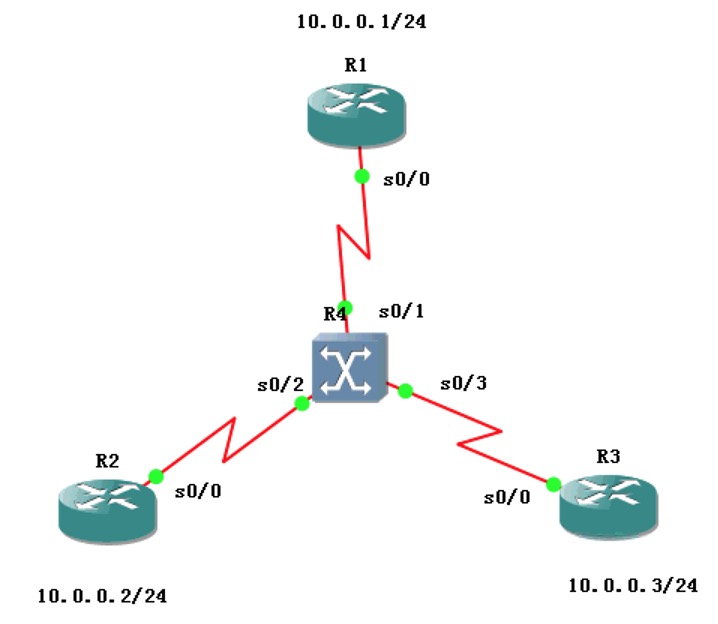
说明:
本次实验,使用路由器当做帧中继交换机,需要使用
frame-relay switching命令,启动帧中继交换机,然后在进行配置;
先配置动态帧中继,是R1、R2、R3之间能够访问
首先配置帧中继交换机 R4配置:
R4>en
R4#conf t
R4(config)#frame-relay switching
R4(config)#int s 0/1
R4(config-if)#encapsulation frame-relay
R4(config-if)#clock rate 64000
R4(config-if)#frame-relay intf-type dce
R4(config-if)#frame-relay route 102 interface s0/2 201
R4(config-if)#frame-relay route 103 interface s0/3 301
R4(config-if)#no sh
R4(config-if)#int s 0/2
R4(config-if)#encapsulation frame-relay
R4(config-if)#clock rate 64000
R4(config-if)#frame-relay intf-type dce
R4(config-if)#frame-relay route 201 interface s0/1 102
R4(config-if)#int s 0/3
R4(config-if)#encapsulation frame-relay
R4(config-if)#clock rate 64000
R4(config-if)#frame-relay intf-type dce
R4(config-if)#frame-relay route 301 interface s0/1 103
R4(config-if)#no sh
查看R4帧中继配置:
R4(config)#end
R4#show frame-relay route
Input Intf Input Dlci Output Intf Output Dlci Status
Serial0/1 102 Serial0/2 201 inactive
Serial0/1 103 Serial0/3 301 inactive
Serial0/2 201 Serial0/1 102 inactive
Serial0/3 301 Serial0/1 103 inactive
说明:
可以到,所有s0/1 s0/2 s0/3 的帧中继配置都是
inactive,毕竟其他的路由器都没有配置;
R1配置:
R1>en
R1#conf t
R1(config)#int s 0/0
R1(config-if)#encapsulation frame-relay
R1(config-if)#ip add 10.0.0.1 255.255.255.0
R1(config-if)#no sh
R2配置:
R2>en
R2#conf t
R2(config)#int s 0/0
R2(config-if)#encapsulation frame-relay
R2(config-if)#ip add 10.0.0.2 255.255.255.0
R2(config-if)#no sh
R3配置:
R3>en
R3#conf t
R3(config)#int s 0/0
R3(config-if)#encapsulation frame-relay
R3(config-if)#ip add 10.0.0.3 255.255.255.0
R3(config-if)#no sh
配置好后,再次查看R4帧中继交换机中的状态:
R4#show frame-relay route
Input Intf Input Dlci Output Intf Output Dlci Status
Serial0/1 102 Serial0/2 201 active
Serial0/1 103 Serial0/3 301 active
Serial0/2 201 Serial0/1 102 active
Serial0/3 301 Serial0/1 103 active
此时的状态都是active;
测试ping一下:
R1测试:
R1#ping 10.0.0.2
Type escape sequence to abort.
Sending 5, 100-byte ICMP Echos to 10.0.0.2, timeout is 2 seconds:
!!!!!
Success rate is 100 percent (5/5), round-trip min/avg/max = 8/22/48 ms
R1#ping 10.0.0.3
Type escape sequence to abort.
Sending 5, 100-byte ICMP Echos to 10.0.0.3, timeout is 2 seconds:
!!!!!
Success rate is 100 percent (5/5), round-trip min/avg/max = 8/24/80 ms
R2测试:
R2#ping 10.0.0.1
Type escape sequence to abort.
Sending 5, 100-byte ICMP Echos to 10.0.0.1, timeout is 2 seconds:
!!!!!
Success rate is 100 percent (5/5), round-trip min/avg/max = 8/20/44 ms
R2#ping 10.0.0.3
Type escape sequence to abort.
Sending 5, 100-byte ICMP Echos to 10.0.0.3, timeout is 2 seconds:
.....
Success rate is 0 percent (0/5)
R3测试:
R3#ping 10.0.0.1
Type escape sequence to abort.
Sending 5, 100-byte ICMP Echos to 10.0.0.1, timeout is 2 seconds:
!!!!!
Success rate is 100 percent (5/5), round-trip min/avg/max = 8/16/40 ms
R3#ping 10.0.0.2
Type escape sequence to abort.
Sending 5, 100-byte ICMP Echos to 10.0.0.2, timeout is 2 seconds:
.....
Success rate is 0 percent (0/5)
结论:
1、可以从R1通向R2和R3
2、R2和R3之间无法通信
R2和R3之间的通信问题稍后解决
再配置静态的帧中继:
需要分别修改R1、R2和R3的配置;如下
R1静态帧中继修改:
R1(config)#int s 0/0
R1(config-if)#no frame-relay inverse-arp
R1(config-if)#frame-relay map ip 10.0.0.2 102 broadcast
R1(config-if)#frame-relay map ip 10.0.0.3 103 broadcast
R1(config-if)#end
R1#show fram
*Mar 1 07:07:04.150: %SYS-5-CONFIG_I: Configured from console by console
R1#show fram
R1#show frame-relay map
Serial0/0 (up): ip 10.0.0.2 dlci 102(0x66,0x1860), static,
broadcast,
CISCO, status defined, active
Serial0/0 (up): ip 10.0.0.3 dlci 103(0x67,0x1870), static,
broadcast,
CISCO, status defined, active
R2静态帧中继修改:
R2(config)#int s 0/0
R2(config-if)#no frame-relay inverse-arp
R2(config-if)#frame-relay map ip 10.0.0.1 201 broadcast
R2(config-if)#end
R2#show frame-relay
*Mar 1 07:09:09.882: %SYS-5-CONFIG_I: Configured from console by console
R2#show frame-relay map
Serial0/0 (up): ip 10.0.0.1 dlci 201(0xC9,0x3090), static,
broadcast,
CISCO, status defined, active
R3静态帧中继修改:
R3(config)#int s 0/0
R3(config-if)#no frame-relay inverse-arp
R3(config-if)#frame-relay map ip 10.0.0.1 301 broadcast
R3(config-if)#end
R3#show frame-relay
*Mar 1 07:09:54.534: %SYS-5-CONFIG_I: Configured from console by console
R3#show frame-relay map
Serial0/0 (up): ip 10.0.0.1 dlci 301(0x12D,0x48D0), static,
broadcast,
CISCO, status defined, active
此时就配置好了,下面进行测试:
R1测试:
R1#ping 10.0.0.2
Type escape sequence to abort.
Sending 5, 100-byte ICMP Echos to 10.0.0.2, timeout is 2 seconds:
!!!!!
Success rate is 100 percent (5/5), round-trip min/avg/max = 8/28/72 ms
R1#ping 10.0.0.3
Type escape sequence to abort.
Sending 5, 100-byte ICMP Echos to 10.0.0.3, timeout is 2 seconds:
!!!!!
Success rate is 100 percent (5/5), round-trip min/avg/max = 8/30/92 ms
R2测试:
R2#ping 10.0.0.1
Type escape sequence to abort.
Sending 5, 100-byte ICMP Echos to 10.0.0.1, timeout is 2 seconds:
!!!!!
Success rate is 100 percent (5/5), round-trip min/avg/max = 8/24/84 ms
R2#ping 10.0.0.3
Type escape sequence to abort.
Sending 5, 100-byte ICMP Echos to 10.0.0.3, timeout is 2 seconds:
.....
Success rate is 0 percent (0/5)
R3测试:
R3#ping 10.0.0.1
Type escape sequence to abort.
Sending 5, 100-byte ICMP Echos to 10.0.0.1, timeout is 2 seconds:
!!!!!
Success rate is 100 percent (5/5), round-trip min/avg/max = 8/24/52 ms
R3#ping 10.0.0.2
Type escape sequence to abort.
Sending 5, 100-byte ICMP Echos to 10.0.0.2, timeout is 2 seconds:
.....
Success rate is 0 percent (0/5)
测试结果和动态是一样的,那么下面解决两个问题:
1、R2和R3的通信
2、不能ping通自己
解决:
R2配置:
R2(config)#int s 0/0
R2(config-if)#frame-relay map ip 10.0.0.2 201 broadcast
R2(config-if)#frame-relay map ip 10.0.0.3 201 broadcast
R2(config-if)#end
R2#show frame-relay map
Serial0/0 (up): ip 10.0.0.1 dlci 201(0xC9,0x3090), static,
broadcast,
CISCO, status defined, active
Serial0/0 (up): ip 10.0.0.2 dlci 201(0xC9,0x3090), static,
broadcast,
CISCO, status defined, active
Serial0/0 (up): ip 10.0.0.3 dlci 201(0xC9,0x3090), static,
broadcast,
CISCO, status defined, active
R3配置:
R3(config)#int s 0/0
R3(config-if)#frame-relay map ip 10.0.0.3 301 broadcast
R3(config-if)#frame-relay map ip 10.0.0.2 301 broadcast
R3(config-if)#end
R3#show frame-relay map
Serial0/0 (up): ip 10.0.0.1 dlci 301(0x12D,0x48D0), static,
broadcast,
CISCO, status defined, active
Serial0/0 (up): ip 10.0.0.2 dlci 301(0x12D,0x48D0), static,
broadcast,
CISCO, status defined, active
Serial0/0 (up): ip 10.0.0.3 dlci 301(0x12D,0x48D0), static,
broadcast,
CISCO, status defined, active
此时就解决了R2和R3的通信和ping自己的问题了,下面进行测试:
R2测试:
R2#ping 10.0.0.02
Type escape sequence to abort.
Sending 5, 100-byte ICMP Echos to 10.0.0.2, timeout is 2 seconds:
!!!!!
Success rate is 100 percent (5/5), round-trip min/avg/max = 16/34/108 ms
R2#ping 10.0.0.2
Type escape sequence to abort.
Sending 5, 100-byte ICMP Echos to 10.0.0.2, timeout is 2 seconds:
!!!!!
Success rate is 100 percent (5/5), round-trip min/avg/max = 16/28/76 ms
R3测试:
R3#ping 10.0.0.3
Type escape sequence to abort.
Sending 5, 100-byte ICMP Echos to 10.0.0.3, timeout is 2 seconds:
!!!!!
Success rate is 100 percent (5/5), round-trip min/avg/max = 16/38/120 ms
R3#ping 10.0.0.2
Type escape sequence to abort.
Sending 5, 100-byte ICMP Echos to 10.0.0.2, timeout is 2 seconds:
!!!!!
Success rate is 100 percent (5/5), round-trip min/avg/max = 16/36/104 ms
解决
帧中继环境中的动态路由协议 问题1
- 问题1:帧中继是典型的NBMA网络,也就是非广播多路访问网络,并不支持广播,然而包括RIP、EIGRP、OSPF等在内的路由协议都需要组播或广播的支持,那么在帧中继环境下运行上述动态路由协议,会否有问题?
- 帧中继虽然不支持广播,但是可以”模拟“广播的操作,做法即是通过向所有PVC发送一份数据的靠背。
- 在建立PVC的时候,通过invers-arp自动建立的映射,默认就开启上述特性;如果是手工配置映射,则必须加上broadcast关键字;